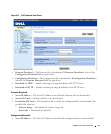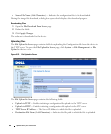
Update with your book title 87
•
Domain Name —
Specifies the domain name for a DHCP client. The domain name may contain up
to 32 characters.
•
NetBIOS WINS Server —
Specifies the NetBIOS WINS name server available to a DHCP client.
•
NetBIOS Node Type —
A parameter that informs the workstation how to resolve the NetBIOS name.
Valid node types are:
–
Blank —
The workstation is not informed as to what type of NetBIOS node the client is.
–
Broadcast —
IP broadcast messages are used to register and resolve NetBIOS names to IP
addresses.
–
Peer-to-Peer —
Point-to-point communications with a NetBIOS name server are used to register
and resolve computer names to IP addresses.
–
Mixed —
A combination (mix) of b-node and p-node communications is used to register and
resolve NetBIOS names. M-node first uses b-node; then, if necessary, p-node. M-node is typically
not the best choice for larger networks because its preference for b-node broadcasts increases
network traffic.
–
Hybrid —
A hybrid combination of b-node and p-node is used. When configured to use h-node, a
computer always tries p-node first and uses b-node only if p-node fails. This is the default.
•
SNTP Server —
Specifies the time server for the DHCP client.
•
Next Server —
Specifies the IP address of the next server in the boot process of a DHCP client. If the
next server in the boot process is not configured, the DHCP Server uses inbound interface helper
addresses as boot servers.
•
Next Server Name —
Specifies the name of the next server in the boot process. The server name may
contain up to 64 characters.
•
Image File Name —
Specifies the name of the file that is used as a boot image. The file name may
contain up to 128 characters.
Excluding Addresses
By default, the DHCP Server assumes that all pool addresses may be assigned to DHCP clients. The user
can specify IP addresses that must not be used. These addresses are referred to as excluded addresses. A
single IP address or a range of IP addresses can be excluded.
The Excluded Addresses page lists the excluded addresses. To open the Excluded Addresses page, click
System
→ DHCP Server → Excluded Addresses in the tree view.


















